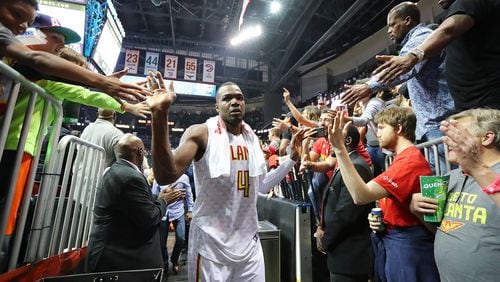If it feels as if the Hawks have been here before, it’s because they have. A year ago, they had to decide whether to spend big to keep Al Horford, even though they knew — or should have known — that re-signing the All-Star wouldn’t make them any better than they’d been. (Being the Hawks, they messed it up. They decided he should stay, then haggled over terms and watched him leave.)
Second verse, same as the first — almost. The Hawks face a similar decision regarding Paul Millsap, who will declare for free agency. The difference: When Horford left, they still had Millsap. If he leaves, what’s left? And is that even the right question?
Millsap is an All-Star, which isn’t the same as being a superstar. Since 2013, he has been the best thing about the Hawks. He’s also 32. A maximum contract would entail $205 million over five seasons, meaning they’d be paying him when he’s 37. Some baseball teams have come to realize that paying a free agent for what he has done, as opposed to what he’s apt to do, is the height of folly. Baseball has a luxury tax but no salary cap. The NBA has both.
The money spent to retain Millsap is money that cannot be spent on someone else. If the Hawks pay Millsap $205 million, they won’t stink next season. If anything, they might be a tad better. They do have good young players in Dennis Schroder, Taurean Prince and — assuming he’s retained as a restricted free agent — Tim Hardaway Jr. But being a tad better than 43-39 is … what? Being 48-34?
A five-game bump would reverse the slide from the 60 wins of 2015 and the 48 of last season, and that’s about all. Had these Hawks won 48 games, they’d have been fifth in the East, which is what they were anyway. Cleveland would still have LeBron, which in this conference is all that matters. Boston finished first in the East and could have the No. 1 pick in the June draft. Washington finally seems to be on to something. Toronto is bad in the playoffs but has averaged 51 wins over the past four regular seasons.
Would keeping Millsap and Hardaway nudge the Hawks above any of the four teams that just finished ahead of them? If not, why spend massive money to maintain a middling status quo? That's an issue this front office must address when the Hawks again have a functioning front office.
Mike Budenholzer is coach but no longer president of basketball operations. Wes Wilcox is out as general manager. It’s believed that the partnership broke over Millsap. Whispers have long held that the then-GM wanted to trade the Hawks’ best player before the February deadline but the then-president-and-still-coach said no. Owner Tony Ressler has since said he’d have vetoed such a deal, so the point might have been moot. Still, that apparent schism underscored the club’s latest dilemma.
The Hawks have made the playoffs 10 years running. Here’s what a decade of postseason play has brought: One conference final appearance (got swept); four other trips to the semis (swept three times), and five Round 1 exits. They’ve been good but not good enough. If they re-up Millsap/Hardaway, they still won’t be good enough, and they’ll have two more fat contracts to set alongside Dwight Howard’s ($46.3 million remaining) and Kent Bazemore’s ($54.3 million remaining).
So what’s the alternative? Rip it up and start anew? I wouldn’t go that far, given that the most audacious show of tanking — Sam Hinkie’s “process” in Philadelphia, although Hinkie is no longer the processor — hasn’t lifted the 76ers above the lottery. (Although with Ben Simmons, Joel Embiid, Jahlil Okafor, Dario Saric and maybe two top five picks in June, I’d rather be the Sixers than the Hawks.) But we just saw the effect the lottery can have.
By making the playoffs 10 years running, the Hawks went nearly a decade between lottery picks. They bought last year’s No. 12 selection from Indiana via the Jeff Teague trade. By season’s end, Prince was starting. In the grand scheme, it might behoove the Hawks to skip the Millsap megabucks and ride out a dip that would allow new management to take a lottery shot come 2018. (A half-tank, if you will.)
Lest we forget, tanking ultimately generated the beginning of this playoff run. Billy Knight dumped everything and assembled Horford, Marvin Williams and Josh Childress, all lottery guys, and Josh Smith, the 17th pick in 2004. (We choose to forget Shelden Williams, No. 5 overall in 2006.) It took a while — and major trades for Joe Johnson and Mike Bibby — for the young core to coalesce, but finally it did.
The Hawks are already slipping. Keeping Millsap might arrest the slide for a year or so, but his massive salary would compromise the franchise’s future. Sometimes a step back is needed to move forward. This is such a time.







